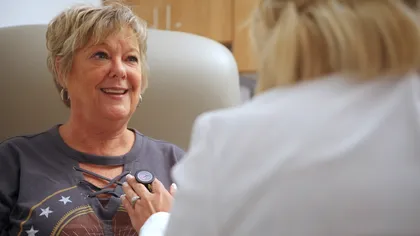It’s 5:30 on a Friday night and your child has just returned from a friend’s house complaining of significant pain in his forearm. When he says he can’t bend his wrist, you immediately start considering your options. Should you “wait and see” or take a trip to the Emergency Department? Could a walk-in clinic be the answer?
Knowing the difference between the care provided at Sarah Bush Lincoln’s walk-in clinics and the care provided in the emergency department could mean the difference between life and death in a severe medical emergency. In less severe situations, it could mean getting the care you need without delay.
Walk-in clinics help fill a vital gap when people are sick or injured at times when their regular doctors are not available, explained Daniel Bommelje, DO, Medical Director of Sarah Bush Lincoln’s three walk-in clinics. “Our walk-in clinics have spread like wildfire during the past three years,” he said, noting that the clinics fill a community need for expanded medical care. The Mattoon and Charleston walk-in clinics exceeded 35,000 visits last year, a volume close to that of the SBL Emergency Department. Sarah Bush Lincoln opened another walk-in clinic in Tuscola in September.
While the clinics provide a great service, Dr. Bommelje said there are distinct differences in the levels of care that are provided at walk-in clinics verses emergency departments. “If your sudden illness or injury is something you would normally feel comfortable addressing with your primary care doctor, then the walk-in clinic is probably the best place to seek care,” he said. “We offer simple point-of-care testing-– the same kind of testing that you would find at your doctor’s office.”
However, he stresses, “A walk-in clinic is not a mini Emergency Department. We want you to know that if you’re having chest pain, if you’re short of breath, if you’re having abdominal pain, if you’re having the worst headache of your life, then you should go straight to the ER. Those types of complaints need the more complex workup that can only be done in the Emergency Department.” The ED is equipped and staffed for more complex or critical needs, including life-threatening situations ranging from heart attack and stroke to traumatic injuries.
The following questions and answers will help you choose when to seek care at a Sarah Bush Lincoln walk-in clinic and when to go straight to the Emergency Department.
What is a Walk-in Clinic?
The purpose of a walk-in clinic is to complement the care you receive from your primary care provider by offering same-day care when your regular provider is not available. A walk-in clinic provides high-quality medical care for common, non-life-threatening conditions in people of all ages.
What services are provided it the Walk-in Clinics?
Clinic providers treat people ages 6 months and older for medical conditions that need care right away, but are not life-threatening. The clinics also offer diagnostic services like X-ray and simple blood and urine tests. They also provide school and sports physicals, however Medicaid cannot be billed for any physicals. Walk-in clinics are not intended to treat chronic conditions or serious medical conditions. Patients who appear with severe symptoms will be referred to the Emergency Department.
Walk-in clinic personnel often treat:
•Common, non-life-threatening illnesses in children and adults
•Cold and flu
•Minor cuts or lacerations needing stitches
•Sprains, strains and simple fractures
•Earaches, sore throats and coughs
•Bladder infections
•Asthma and similar conditions that require breathing treatments
When should a person head straight to the Emergency Department?
If you are experiencing any of these symptoms, then we encourage you to go straight to the Emergency Department:
• Chest pain
• Stroke-like symptoms
• Shortness of breath
• Severe abdominal pain
• Severe head injury
• Sudden, severe headache
Trust your instinct. If you think it’s something serious, don’t hesitate; go to the nearest emergency room or call 911.
Who will take care of me?
Skilled and friendly healthcare providers including nurse practitioners and physician assistants staff our walk-in clinics. They are trained to do about 90 percent of what family physicians do.
Is a Walk-Clinic more affordable than an Emergency Room visit?
A walk-in clinic visit is normally a lower cost choice than an Emergency Room visit. With many insurance plans, walk-in clinic patients pay co-pays that are similar to what they pay for doctor office visits.
Why is it important to have a primary care provider?
While walk-in clinics definitely provide a service, they are not a substitute for ongoing primary medical care. Rather, primary care providers can deliver ongoing medical care and maintenance to patients in a way that walk-in providers cannot. A primary care provider can refill prescriptions and manage chronic pain. Primary care providers are also best to manage complex medical conditions like hypertension and diabetes, which require ongoing monitoring and lab work. Any person who goes to a SBL walk-in clinic because he does not have a regular provider will be assisted in securing an appointment with a provider who he or she can continue to see.
Do I need an appointment?
No, people are seen on a first-come, first-served basis.
How long will I have to wait?
Patients are seen as quickly as possible, with wait times based on the number of people seeking care and the seriousness of their conditions. Wait times can be viewed at www.sarahbush.org.









